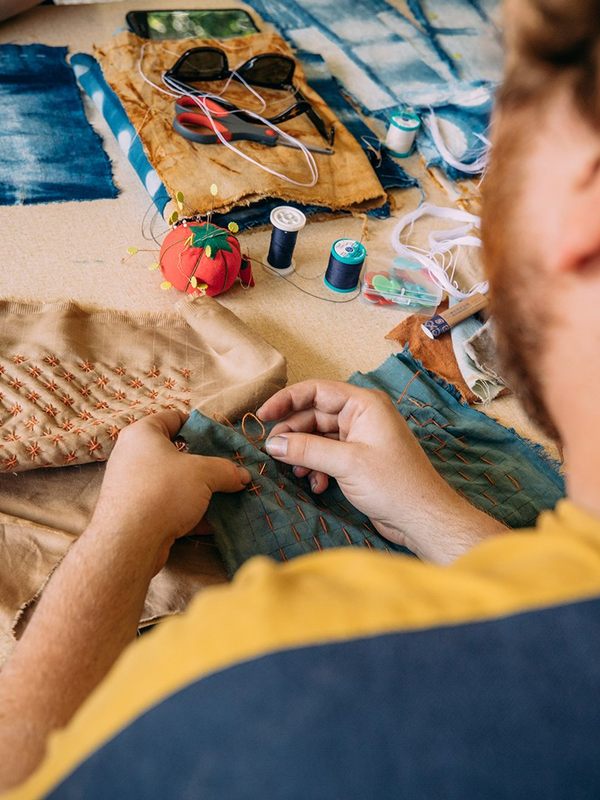Finding Your Stitching Voice: Embroidery With Aaron Sanders Head




In this 3-part seminar, we'll study historical examples of embroidery samplers and create our very own.
Course Description
Throughout history, samplers have been used to showcase artists' needlework skills. Today they can serve as windows to the past, with each motif offering a clue about the people and societies that stitched them together. In this seminar taught by Aaron Sanders Head, you'll have the opportunity examine these historical embroidery samplers, draw on them for inspiration, and explore how they can be personalized to create a contemporary stitching voice unique to you. We'll build our own stitching skillset, covering 4-5 stitches each class. Beginning with simple, straight line stitches, we'll build on what we've learned to create more complex texture and fill stitches—all while creating a beautiful sampler of our own. Along the way, students will learn invaluable hand embroidery techniques, from managing thread and using a hoop to transferring designs—among other tips and tricks for successful stitching.
Syllabus at a Glance
This course includes four total sessions, each lasting 1.5 hours on three consecutive Mondays beginning August 14.
Session 1 (Monday, 8/14, 7–8:30 PM ET) | An overview of historic embroidery samplers: what we can learn from them and how to design our own contemporary version. This includes a deep dive into the tools we'll be using, how to transfer patterns, and the first four basic stitches.
Session 2 (Monday, 8/21, 7–8:30 PM ET) | We'll learn more decorative, sculptural stitches like the chain stitch, fly stitch and feather stitch for creating texture and pattern in our embroidered samplers. We'll also take the basic stitches up a notch with embellishments like the woven back stitch.
Session 3 (Monday, 8/28, 7–8:30 PM ET) | We'll tackle the trickiest stitches, like turkey work and the buttonhole wheel, and practice ways to finish our samplers and prepare them for hanging.
Course Materials
- Embroidery thread: There are lots of options out there! The most common is 6-strand embroidery floss, sold at nearly every craft store, with the most popular brand being DMC. You can also use perle cotton, which comes in a single strand. Other threads (like yarn and sewing thread) can be used to create texture and variation later. I encourage you to get several options in 5-6 corresponding colors.
- Fabric: Preferably cotton or linen. Before committing, make sure you can easily pass your needle through your fabric. Nothing stretchy.
- Needles: I like crewel embroidery needles, but any embroidery needles that your thread will fit in can be used.
- 2 hoops: Preferably a solid wood, plastic, or metal hoop that measures around 8 inches. If your hoop is slightly smaller, that’s fine, but you will have to move it more.
- Marking tool: Heat or water soluble pens are great, like Mark-B-Gone.
- Ruler
- Scissors
Pricing Options
In addition to full-price tickets, a limited number of no-pay spots are available for this course. Please note that these tickets are reserved for those who would not otherwise be able to take this course and who expect to attend all sessions. No-pay spots are distributed via a randomized drawing two weeks before each course begins. For more information and to apply for a no-pay spot, please click here. To learn more about our pricing model and randomized selection process for no-pay spots, please visit our FAQ page.
Community Guidelines for Students
Please take a moment to review our community guidelines for students, which aim to share our classroom ethos and help set the stage for the best possible learning experience.
Atlas Obscura Online Courses
Atlas Obscura Courses offer opportunities for participants to emerge with new skills, knowledge, connections, and perspectives through multi-session classes designed and taught by expert instructors. To learn more about our current course offerings, please visit www.atlasobscura.com/online-courses. For answers to commonly asked questions, check out our FAQ page here.
Founded in 2009, Atlas Obscura created the definitive community-driven guide to incredible places across the planet and is now an award-winning company that shares the world’s hidden wonders in person and online.
Once registered, you’ll receive a confirmation email from Eventbrite that will provide access to each class meeting. Please save the confirmation email as you’ll use it to access all sessions of your course via Zoom.


Aaron Sanders Head is a Southern textile artist focused on natural dyes and hand-stitching. Aaron explores the intersections of practices of the past with contemporary craft, and the ways that sewing and textile arts can aid in increasing diversity and representation in the creative class. He is based in Greensboro, Alabama where he lives in an 1830s home with his partner, musician Tim Higgins, and two cats, Splenda and Turnip. He maintains an active studio practice and extensive dye garden used in his work.
This is an interactive, small-group seminar that meets over Zoom. Students may be encouraged to participate in discussions, work on assignments outside of class, and workshop projects with their instructor or classmates. Due to the interactive nature of this course, we strongly recommend students attend as many live sessions as possible. Within 72 hours after each session meets, students will receive access to a recording of the live session, which they can watch for up to two weeks after the course concludes.
Instructors may use Google Classroom to communicate with students outside of class. While students aren’t required to use Google Classroom, instructors may use this platform to post resources, discussion questions, or assignments. This platform also offers a space for students to connect with one another about course material between sessions.
We provide closed captioning for all of our courses and can share transcripts upon request. Please reach out to us at experiences@atlasobscura.com if you have any questions, requests, or accessibility needs.
There are 30 spots available on this experience.






